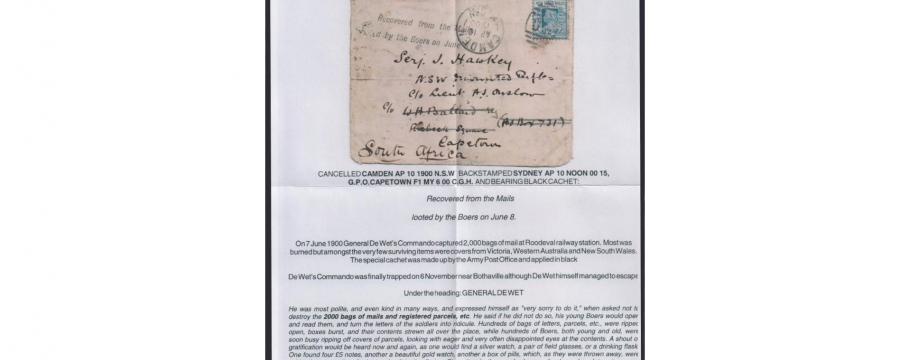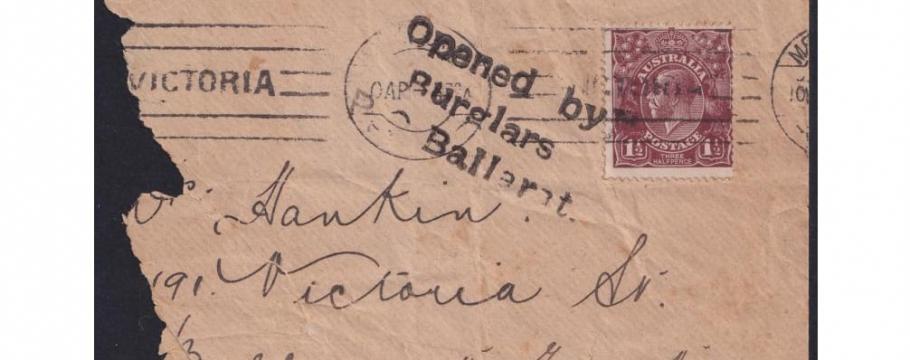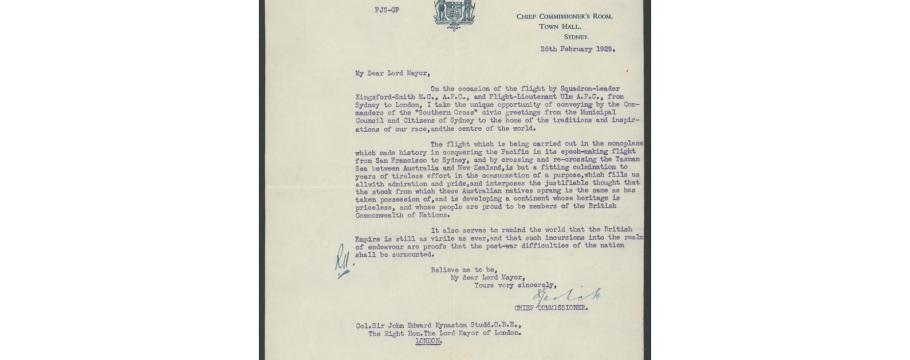









Australian disaster mail holds strong fascination for auction goers
Author: Richard Brewster | Posted: 13th June, 2025
Mail used to be a useful source of income and easy pickings for 19th century Australian bushrangers who regularly held up and robbed the famed Cobb & Co coaches that provided vital communication links between Australia’s major cities and regional towns.
Many of the registered letters contained banknotes and, once opened, the envelopes were then tossed aside.
The fact that one postal article from such a bushranger robbery has survived is remarkable and a highlight of Melbourne-based Abacus Auctions sale of the Brian Peace collection of Delayed, Damaged & Disaster Mail – part of a four-day sale of stamps, postal history, coins and banknotes and sporting memorabilia from 10am Tuesday June 24 to Friday June 27 at 29 Hardner Road, Mount Waverley.
The article (lot 2004), an 1866 Queensland OHMS envelope with ‘Electric Telegraph Station’ imprinted in the lower left corner, was unceremoniously ripped apart in the search for valuables and carefully reconstituted for display.
Now 80, Brian is a trained architect, pilot, author and philanthropist who began collecting stamps at age five, branching out into postal history as an adult.
The 1866 envelope only surfaced after Brian published his ‘Mail Robberies by Bushrangers’ in 2011 and he has authenticated its unique status after documenting 430 bushranger incidents.
The damaged and disaster mail stories are remarkable, many recording momentous events at the time.
One of the distressed letters (lot 2193) was the only document to survive the September 22, 1966 mid-air disintegration of an Ansett-ANA Viscount aircraft en route from Mt Isa to Longreach in Queensland’s outback – in which all 24 occupants were killed.
This was a major event in Australian aviation and the first crash investigation where a flight data recorder or black box had been fitted to the aircraft.
Two covers, lots 2011 and 2012, were belatedly delivered – and marked accordingly with the cause of the delay – to Western Australia after the British Airways aircraft on which they were being carried was hijacked on November 21, 1974 at Dubai on its way to Singapore.
Twenty-three passengers, including Australian Aboriginal activist Kath Walker, who had remained aboard were taken as hostages to Libya and only released in exchange for Palestinian prisoners held in The Netherlands and Egypt after one of their number, a German national, was executed.
A 1900 South Australian envelope (lot 2005) and a New South Wales cover from the same year (lot 2006) are extremely rare examples of surviving incoming mail to Australian soldiers who fought in the Boer War.
Engineer Arthur Elliott lost his life in Iraq during a 1926 pioneer flight from London to Australia when, with pilot Alan Cobham, he was flying below a dust storm.
At first, a burst fuel pipe was thought to be the cause but on landing it was discovered he had been hit and mortally wounded by a bullet fired from the ground.
The rare cover (lot 2057) was part of mail on the flight and the only one returned to England by ship.
Another very rare ripped envelope (lot 2007) has been stamped “Opened by burglars P.O. Ballarat”. This marks the April 1920 weekend robbery of the Ballarat post office when 700 items were ransacked by thieves who were never caught and is one of only two recorded examples.
Famous Australian pioneer aviator Sir Charles Kingsford Smith could have perished during many of his aviation adventures before his luck eventually ran out in 1935 when he disappeared over the Andaman Sea attempting to break the Australia-England speed record.
Two letters (lots 2066 and 2067), related to the famous Coffee Royal Affair, remain from his and co-pilot Charles Ulm’s March 1929 attempt to fly to England from Australia in the famous Southern Cross.
Bad weather in New South Wales delayed the flight which was attempting to fly non-stop to Wyndham in Western Australia over burdened with fuel.
On their arrival, visibility was so poor they missed Wyndham and, running out of fuel, landed on a remote beach.
A broken radio aerial meant they couldn’t call for help and it was 12 days before the pair were located – the search and rescue efforts dubbed the “Coffee Royal Affair” by the media who viewed it as a publicity stunt.
In 1937, the inaugural flight from England to Australia of Imperial Airways flying boat Capricornus met with disaster when it was caught in a snow storm and crashed into the Morvan mountain range in central France killing five of its six occupants.
The mail was recovered the following day and forwarded on to its destination – lot 2130 being one of the letters.
Other mail commemorated several brave or exceptional feats – such as Kingsford Smith’s navigator Sir Patrick Gordon Taylor’s May 1935 in flight efforts to transfer oil by thermos flask from the bung engine on one side of the Southern Cross to the good motor on the other by walking on the wings – for which he received two medals for gallantry.
And the survivors of a Northern Territory crash who stayed alive by eating the crocodile they were supposed to be escorting to the Melbourne Zoo.





